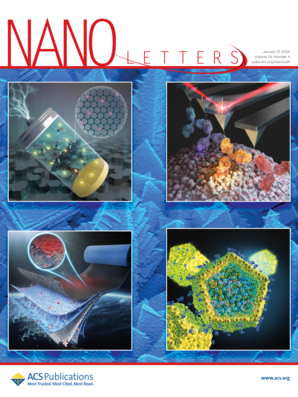直接利用经高频处理的硅光电阴极高效制氢
IF 9.6
1区 材料科学
Q1 CHEMISTRY, MULTIDISCIPLINARY
引用次数: 0
摘要
硅基光电阴极通常被认为是光电化学制氢的理想材料。硅基光电阴极的制备通常需要先用氢氟酸(HF)处理去除氧化层,同时在硅表面不可避免地形成h悬空键。然而,Si-H键在PEC反应中的影响通常被忽略。本文报道了固液界面富集的h -悬空键在PEC产氢过程中发挥多重作用,既能有效地收集Si的光生电子,又能加速界面处析氢反应的动力学。此外,h悬空键引发的偶联制氢机制显著提高了PEC工艺的效率。这项工作表明,经过高频处理的硅光电阴极可以直接用于高效制氢,这无疑将推动硅基光电阴极的研究进入一个新的阶段。本文章由计算机程序翻译,如有差异,请以英文原文为准。

Direct Utilization of a HF-Treated Si Photocathode for Efficient Hydrogen Production
Silicon (Si)-based photocathodes are generally considered as ideal materials for photoelectrochemical (PEC) hydrogen production. The fabrication of Si-based photocathodes usually requires hydrofluoric acid (HF) treatment to remove the oxide layer first, and H-dangling bonds can be formed inevitably on the surface of Si at the same time. However, the impacts of Si–H bonds in the PEC reaction are usually ignored. Here we report that the enriched H-dangling bonds at the solid–liquid interface play multiple roles in PEC hydrogen production, which can both efficiently collect photogenerated electrons from Si and accelerate the kinetics of the hydrogen evolution reaction at the interface. Furthermore, the coupling mechanism of H2 production triggered by H-dangling bonds significantly improves the efficiency of the PEC process. This work demonstrates that the HF-treated Si photocathode can be directly used for efficient hydrogen production, which will undoubtedly force a new phase in the study of Si-based photocathodes.
求助全文
通过发布文献求助,成功后即可免费获取论文全文。
去求助
来源期刊

Nano Letters
工程技术-材料科学:综合
CiteScore
16.80
自引率
2.80%
发文量
1182
审稿时长
1.4 months
期刊介绍:
Nano Letters serves as a dynamic platform for promptly disseminating original results in fundamental, applied, and emerging research across all facets of nanoscience and nanotechnology. A pivotal criterion for inclusion within Nano Letters is the convergence of at least two different areas or disciplines, ensuring a rich interdisciplinary scope. The journal is dedicated to fostering exploration in diverse areas, including:
- Experimental and theoretical findings on physical, chemical, and biological phenomena at the nanoscale
- Synthesis, characterization, and processing of organic, inorganic, polymer, and hybrid nanomaterials through physical, chemical, and biological methodologies
- Modeling and simulation of synthetic, assembly, and interaction processes
- Realization of integrated nanostructures and nano-engineered devices exhibiting advanced performance
- Applications of nanoscale materials in living and environmental systems
Nano Letters is committed to advancing and showcasing groundbreaking research that intersects various domains, fostering innovation and collaboration in the ever-evolving field of nanoscience and nanotechnology.
 求助内容:
求助内容: 应助结果提醒方式:
应助结果提醒方式:


